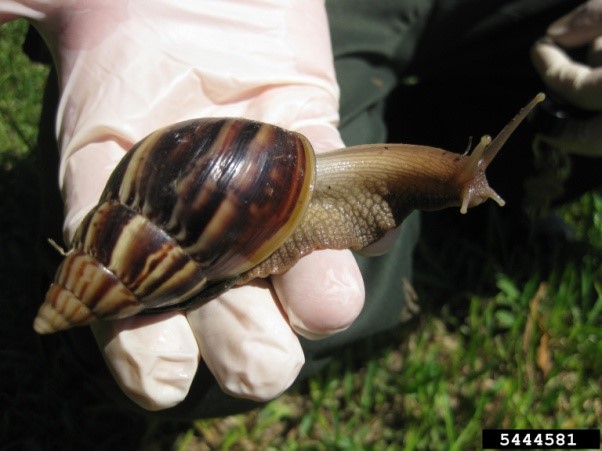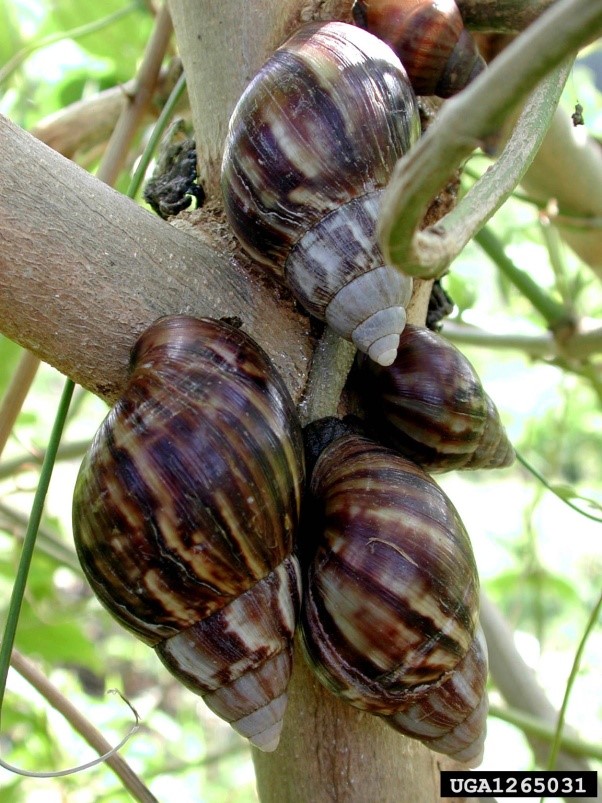
Giant African snail
| Primefact number | Edition | Published | Author |
|---|---|---|---|
| 1394 | First | Apr 2015 | Plant Biosecurity and Product Integrity |


Giant African snail (Achatina fulica) is one of the world’s largest and most damaging land snails. Giant African snail is an exotic plant pest not established on Australia’s mainland. This snail is a serious threat to Australia’s environment.
It prefers warm tropical conditions but can survive temperatures lower than 2°C and higher than 30°C by becoming dormant.
Sunshine will kill Giant African snail so it is mostly active at night time. During the day the snail burrows underground or retreats into its shell.
Notifiable status
Giant African snail (Achatina fulica) is a notifiable plant pest in NSW.
All notifiable plant pests and diseases must be reported within 1 working day. You can report notifiable plant pests and diseases by one of the following methods:
- Call the Exotic Plant Pest Hotline 1800 084 881
- Email biosecurity@dpi.nsw.gov.au with a clear photo and your contact details
- Complete an online form
A full list of notifiable plant pests and diseases can be found in Schedule 2 of the NSW Biosecurity Act 2015.
Impacts
Giant African snail will eat over 500 different plant species. Most damage is caused to vegetable crops, flowers and other ornamentals.
Internationally there is interest in GAS as a meat product and it is marketed in Europe and America. However GAS meat has been reported to transfer bacteria and parasites to humans if raw or poorly cooked snail is consumed. Disease transmission is also possible if snails are handled with bare hands.
Giant African snail is a nuisance to humans when large infestations occur due to the stench that emanates from dead snails.
Decaying snail shells can alter soil properties when calcium carbonate from shells neutralises acid soils.
Description
Giant African snail shells can grow to 12 cm diameter and 20 cm length, although more commonly 5–10 cm long.
The shell is conical, tapering to a point, with 7–9 whorls when fully grown.
Shell colouration is affected by environmental conditions as well as genetic variability of the source of the population. Shells are sometimes described as light brown with dark brown stripes while at other times described as reddish brown with weak yellowish vertical markings.
Lifecycle
Giant African snail is hermaphroditic. Both partners of a mating pair will produce offspring as they can simultaneously fertilise each other.
Lifespan is generally 3–5 years but periods of hibernation can prolong life up to 9 years.
Sexually mature after 6 months, GAS can lay over 1000 eggs in a lifetime. In ideal conditions, eggs will hatch 11 days after being laid.
Host range
Giant African snail will feed on a broad range of host plants. Hatchlings will mostly eat sand and rocks for shell formation. Older snails prefer to feed on vegetation including crop plants such as cocoa, banana, beans, brassicas, cucurbits, peas, beans, and ornamental plants.
Spread
Highly adaptive to a wide range of conditions, giant African snail will modify its lifecycle to suit the local environment.
Although GAS can move up to 50 m overnight, on average it will not move more than 250 m in one year.
Trade and transport are the main mechanisms of human assisted long distance dispersal. Giant African snail has been found attached to shipping containers and machinery. Eggs have been found in soil associated with imported goods.
Distribution
Giant African snail is native to coastal east Africa but is now found across Asia, the Pacific, the Americas and Europe.
Giant African snail occurs in coastal and native environments, agricultural crops and plantations, urban areas and scrub.
Within Australia, GAS has established on Christmas Island but is kept at low population levels due to predation by native red crabs. On the mainland GAS has been intercepted and destroyed at port facilities.

